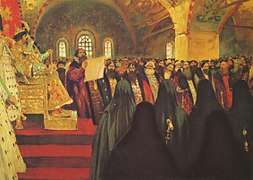Zemsky Sobor
The zemsky sobor (Russian: зе́мский собо́р, IPA: [ˈzʲemskʲɪj sɐˈbor], lit. assembly of the land) was a Russian parliament of the feudal Estates type, active in the 16th and 17th centuries.

It could be summoned either by tsar, or patriarch, or the Boyar Duma. Three categories of population, comparable to the Estates-General of France or the modern day U.K. parliament, but with the numbering of the first two Estates reversed, participated in the assembly:
- Nobility and high bureaucracy, including the Boyar Duma. “Lords temporal” using the English terminology.
- The Holy Sobor of high Orthodox clergy. “Lords spiritual” using English terminology.
- Representatives of merchants and townspeople (third estate) or “commons.”
The first zemsky sobor was held by tsar Ivan the Terrible in 1549. During his reign he held a number of such gatherings and they became a common tool used to enact major pieces of legislation or to decide controversial issues. Although the Sobors were primarily a tool used to rubberstamp decisions that Ivan had already made, sometimes initiative was taken by the lower nobility and townsfolk. For instance, the tsar was scandalized when the assembly of 1566 asked him to abolish the Oprichnina.
When the Rurik Dynasty died out in 1598 it was a sobor that appointed Boris Godunov as the next tsar. Another grand council, featuring even peasants, elected Mikhail Romanov to take the throne in 1613 after the Time of Troubles. During Mikhail's reign, when the Romanov dynasty was still weak, such assemblies were summoned annually.
Once the Romanovs were firmly in power, however, the sobor gradually lost its power. A major council assembled to ratify the Treaty of Pereyaslav in 1654 was the last for thirty years. The last sobors were held by the great Galitzine in 1682, to abolish the mestnichestvo, and in 1684, to ratify the "Eternal Peace" with Poland.
1922 Zemsky Sobor of Amur region
Four years after the death of the last Russian tsar, on July 23, 1922, General M.K. Dieterichs of the Far Eastern White Army convened the Zemsky Sobor of Amur region (Приамурский Земский Собор) in Vladivostok. This sobor called on all Russian people to repent for the overthrow of the tsar and proclaimed a monarchy by naming Grand Duke Nikolai Nikolaievich Romanov as tsar. Patriarch Tikhon (who was not present; neither was the Grand Duke) was named as the honorary chairman of the sobor. Two months later the Amur region fell to the Bolsheviks.
Further reading
- S.L. Avaliani, "Литературная история земских соборов" [Literary History of the Zemsky Sabors]. Odessa: 1916.
- John Keep, "The Decline of the Zemsky Sobor," in Power and the People: Essays on Russian History. Boulder, CO: East European Monographs, 1995; pp. 51-72.